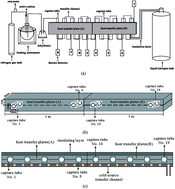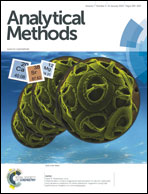Construction of a fractional condensation device and its application in the analysis of volatile compounds from tobacco†
Abstract
A novel fractional condensation device was constructed for the analysis of complex volatile constituents in cut tobacco. With ultra-cold (−150 °C) nitrogen gas as the cold source, a temperature gradient (−15 °C to −70 °C) along a heat transfer plate and capture tubes arranged in parallel was formed when cold nitrogen gas passed through the condensation transfer channel arrayed with different interval spaces. Volatile components with different boiling points were condensed and separated gradually in the capture tubes according to their saturated vapor pressures at different temperatures. With cut tobacco as the model sample, characteristics of the cold source, arrangement of the cold source transfer channel, the flow rate of the carrier gas and the baking temperature were investigated to optimize the fractional condensation. Gas chromatography/mass spectrometry was coupled with this device to analyze volatile components in different capture tubes. Under the optimized conditions of the baking temperature of 150 °C, the carrier gas flow rate of 500 mL min−1 and the condensate temperature gradient from −15 °C to −70 °C, 30 important volatile components related to tobacco flavor and taste were captured separately by different capture tubes.


 Please wait while we load your content...
Please wait while we load your content...